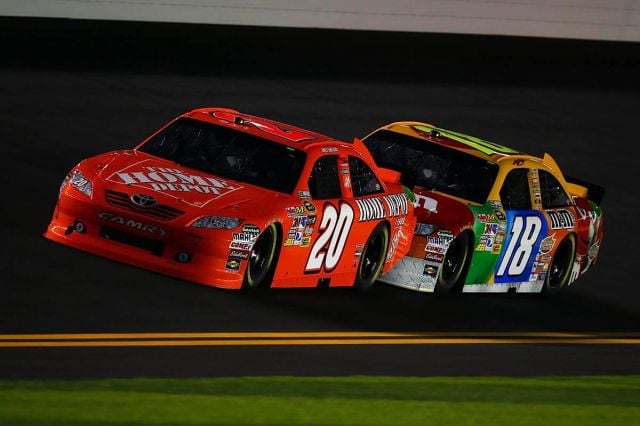Lake Speed Jr. is a certified lubrication specialist working for Joe Gibbs Driven motor oils. He’s the son of former NASCAR driver and team owner Lake Speed. A former crew member for Bill Elliott at Melling Racing, Speed joined the Joe Gibbs team in 2004. — Editor
When Joey Logano ran over 203 mph at Daytona in 2011, NASCAR responded with rule changes designed to break up the two-car draft. The idea seemed simple: shrink the cooling air inlet and locate the inlet so that two-car drafting would completely close the opening on the trailing car. These changes would cause that engine to lose cooling and thereby break-up the two-car draft.
NASCAR must have forgotten that we are racers, and we will continue to try to find ways to go faster. That is our job, and it is what we love to do.
Using oil as a coolant
These new lubricant technologies would not have been developed had NASCAR not changed the rules.
–Lake Speed Jr.
You see, with the two-car draft, only one car ran high oil and water temperatures. The car leading the pair ran cool; the car pushing ran hot. This swapping effect allowed the engine (and the oil and water) to cool down. It was common to see oil temperatures above 280F during the race. Previously, 220F was normal and 240F was cause for alarm. Of course, the “cold” temperatures of 220F allowed us to use very thin oils 0W-10. Now with temperatures reaching 300F, we increased the viscosity of the oil to a 0W-20. That was a step in the right direction, but pack racing led to sustained high temperatures.
With pack racing, everyone behind the leader has reduced airflow through the coolers. As a result, coolant temperatures remained high throughout the race – the engines never got a chance to cool down.
Modern NASCAR engines have a lot of internal oil leaks–piston oilers, valve spring squirters, cam sprayers–and all of these leaks conspire to reduce oil pressure. High oil temperatures cause the oil to thin out, and this results in lower oil pressure. Since these engines must make maximum horsepower, modifying the oil pump is not your first choice. A wider pressure section puts more drag on the pump. Speeding up the pump can cause cavitation at high engine speed, so we had to find an alternative.
 We could have gone to a much heavier oil, say a 10W-40. That would have raised oil pressure. However, a thicker oil actually generates more oil temperature, so we did not want to do something that contributed to higher temperatures.
We could have gone to a much heavier oil, say a 10W-40. That would have raised oil pressure. However, a thicker oil actually generates more oil temperature, so we did not want to do something that contributed to higher temperatures.
What we needed was a lightweight oil that did not thin out as much at higher temperatures. We found that oil from Chevron-Phillips. One of only three companies that actually make PAO synthetic base oil, Chevron-Phillips has recently pioneered a new generation of synthetic base oils that provides greater thermal stability. Developed for Wind Turbine gear boxes, these new synthetic base oils provide a much higher Viscosity Index. The higher the Viscosity Index, the less the oil thins out at higher temperatures.
Using these new higher Viscosity Index base oils from Chevron-Phillips, we created a new 0W-10 oil that would not thin out too much at high temperature. Joey Logano won the Nationwide race at Talladega using this new oil.
These new lubricant technologies would not have been developed had NASCAR not changed the rules. They intended to slow us down. Instead we came up with a new and different way to go faster. I guess that is why they say necessity is the mother of invention.
Of course the lessons learned restrictor plate racing at Daytona and Talladega always make their way into the other engines. Learning the limits of piston and valve spring temperatures in a plate engine allow you to push higher in a non-restrictor plate engine. Before you know it, cars are running hotter and faster at Pocono because of a rule change at Daytona. That is how new engine technologies are born from unintended consequences, and this is what makes coming to work each day fun and exciting.




















